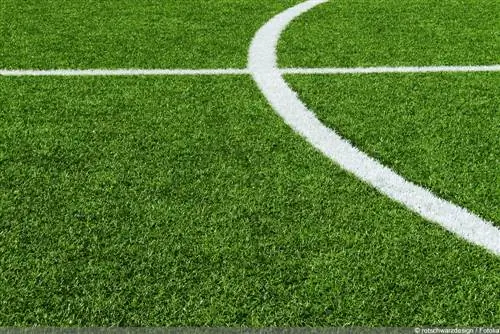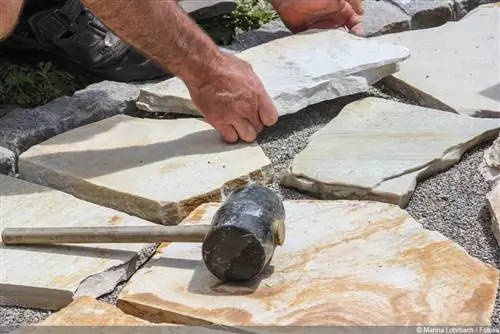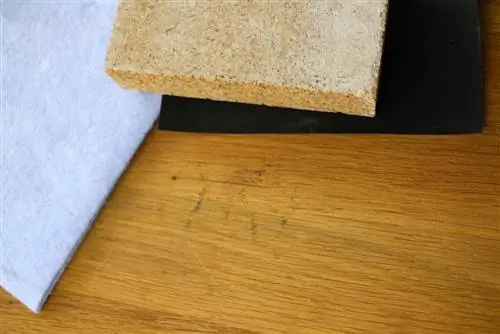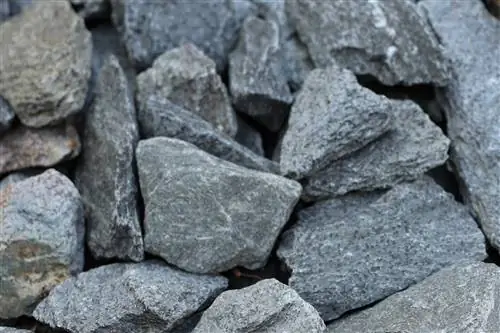- Author admin [email protected].
- Public 2023-12-17 03:39.
- Last modified 2025-01-24 12:45.
Nowadays there are lawn carpets that are an exact replica of a real lawn and can hardly be distinguished from it at first glance. This makes artificial turf more and more popular. You can lay it yourself quite easily. You can find out everything you know about it and how to proceed step by step in the guide.
Advantages: grass carpet vs. real grass
Real grass
Real lawn is demanding to maintain if it is intended to serve as a visual eye-catcher. It suffers from severe stress, such as when children run around, especially when it is damp. Weeds need to be pulled out, they need regular cuts from spring to autumn, they need to be fertilized and occasionally scarified. And if the soil and lighting conditions are not optimal, it thrives poorly.
Artificial grass
The grass carpet, on the other hand, is significantly more robust than normal garden lawn and, depending on the quality standard, also more durable than special play lawn.
With this, no turf can be damaged, there is no need to cut the lawn and no additional time needs to be invested in maintenance. But what is particularly advantageous is that it can be used to cover areas where real lawn would have no chance or where the conditions do not allow real lawn due to its heavy weight, such as in many places on balconies or roof terraces. But in order to benefit from the advantages, professional preparation, design and processing are required.
Laying lawn carpet yourself?
As a rule, anyone can easily lay artificial turf themselves without the need for an experienced craftsman. However, you should leave the installation of professional artificial turf to a specialist. These types of artificial turf are mostly used for areas where meticulous work is required, such as golf courses or football fields. For normal use on terraces, balconies or in the garden, you can easily prepare the surface, cut it to size and install it yourself using the following step-by-step instructions.
Materials needed

What you need depends on what the surface is like.
Laying on solid, level ground without soil
- Cutter knife (carpet knife)
- Artificial grass adhesive
- The amount of grass carpet required
- Fixing anchors if required
- Measuring tape
- Silver or quartz sand
- Coarse broom
Laying on ground surface instead of real grass:
- Spade when real grass needs to be removed
- Curled sand or gravel (0/5 grain size)
- vibration plate
- Long straight board or batten
- Weed fleece
- Ground anchor
- Lawn Carpet Glue
- Silver or quartz sand
- Coarse broom
- Measuring tape
Step 1: Surface preparation
Solid surface
If the surface is flat and solid, as is usually the case on concrete floors or paved surfaces, this
cleaned of dirt and all unevenness such as stones. It is best if the surface is dry before laying. This prevents moisture from forming and makes laying easier.
Loose underground
If you would like to replace real lawn with artificial turf or cover an area of ground with artificial turf, proceed as follows:
- Remove lawn, flowers, weeds or similar from the ground
- Dig up soil about 10 to 15 centimeters
- Fill with crushed sand or gravel (make sure there is a height of 2 centimeters on curbs)
- Compact the sand or gravel layer with the vibrating plate
- Then remove excess using a straight batten or board
- Lay weed fleece over the entire area - it must lie completely flat and must not have any bumps or wrinkles
- Weed fleece provided with ground anchors so that it does not slip when laying the lawn
Step 2: Cut the grass carpet to size
Cut the individual strips roughly to size. This makes it easier for you to adjust the individual lengths later, especially for large areas, and long strips are easier to handle when laid correctly. Leave the ends of the strips to rest for now and only cut them when gluing is done. Only the first landing point of the individual tracks should end exactly at the house or a curb.
Step 3: Roll out

Place the cut panels in their place. Make sure that the strips are placed close together so that when they are glued later, they connect directly to each other without leaving any gaps. For a better look, the panels are rolled away from the house. This is based on the so-called pile direction that artificial turf has. For this reason, the lawn carpet should always be rolled out in straight strips. As soon as it lies at an angle, the existing pile direction makes the look more uneven.
Step 4: Glue preparation
There are various options available for gluing the individual strips:
- Glue the outer edges together with a 2-component adhesive
- Fix with a seam tape or also called lawn tape (similar to double-sided adhesive tape)
- With the Easyklit system, in which Velcro connections ensure that the individual panels hold together
2-component adhesive
- Always start from the first track laid out at the beginning
- Apply the glue liberally to the outer edges, piece by piece
- Connect the artificial turf tracks next to each other
- After each gluing process, run your hand over the seams so that they are pressed out and leveled
- The outer edge, which does not connect to the next strip, is attached with ground anchors or glued to curbs or to the solid surface
- Do this for each strip until the last strip is glued
Seam tape/lawn tape
- First fix the outermost edge of the lawn using ground anchors or tape
- To use tape, the lawn edges must be folded inward by approximately 30 to 50 centimeters
- If the panels are next to each other, both edges must be folded over
- Place the seam tape/lawn tape in the middle so that it will later be covered equally by the right and left strips
- With double-sided adhesive lawn tape, the lower protective film is first removed on solid surfaces and stuck to the surface
- Remove the top protective film and carefully fold out one side of the web and then the other onto the band/tape
- Press the seams firmly
- Make sure there is an almost seamless transition between two tracks
- After each gluing process, run your hand over the seams so that they are pressed out and leveled
- Do this for all panels until you have glued the last panel
Tip:
Always remove the protective film in the direction opposite to the direction of the pile. This allows any artificial grass blades that may be lying down to be raised up.
System
- Prepare the lawn carpet strips in the same way as when gluing them with seam tape or lawn tape
- Fold the edges of the strip inwards and attach part of the Velcro fastener here
- This should end right at the edge
- Place the opposite part of the Velcro system on the floor
- You can either attach this to a solid surface with a 2-component adhesive or fix it to the gravel/sand layer with fastening anchors
- Fold back the rolled lawn edges and press them firmly
- Make sure the track next to it is seamless
- There must not be any air spaces in which moisture could collect
- If small gaps are still visible, you can correct them at any time using the Velcro system
Step 5: Cutting the Edges

Before you glue the edges of the individual strip ends, they must be cut to fit precisely. This particularly applies to artificial turf that ends on curbs or house walls. The rest of the membranes should have already been optimally laid and glued. In this way it is ensured that there is no longer any displacement that could possibly influence the path length. To do this, use a cutter or conventional carpet knife. Alternatively, you can also use a household knife if it is very sharp. Cutting is always done in the pre-modeled areas, which can be clearly seen on the back of the grass carpet.
Last step: erecting the artificial turf
As a result of being rolled up and often as a result of production, the artificial grass blades are often very flattened and do not stand upright like real grass. You can easily help here:
- Spread silver or quartz sand on the artificial turf surface (approx. 5 to 10 kilograms per square meter)
- Sweep over the lawn with a coarse broom in the opposite direction to the pile
- Sweep up the sand at the end of the lawn and sweep it up as much as possible
- Sand residue sinks in over time
Tip:
The lawn carpet can also be cleaned with a vacuum cleaner and even a slightly damp mop can be used to remove dust or coarse dirt. Always make sure that you work against the direction of the pile to prevent the artificial turf from being pushed down.






